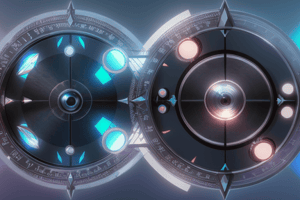Podcast
Questions and Answers
What type of lenses have a bulging center and are used to form images and magnify objects?
What type of lenses have a bulging center and are used to form images and magnify objects?
Convex Lenses
Which type of lenses have a hollow center and are used to correct refractive errors like myopia?
Which type of lenses have a hollow center and are used to correct refractive errors like myopia?
Concave Lenses
What are the two types of lenses that combine the properties of both convex and concave lenses?
What are the two types of lenses that combine the properties of both convex and concave lenses?
Double Convex Lenses and Double Concave Lenses
What type of lenses have no curvature and are used to cancel out the effects of other lenses?
What type of lenses have no curvature and are used to cancel out the effects of other lenses?
What visual disorders are lenses often used to correct?
What visual disorders are lenses often used to correct?
What type of lens is used to correct myopia?
What type of lens is used to correct myopia?
How does hyperopia affect the focus of light in the eye?
How does hyperopia affect the focus of light in the eye?
What type of lens is used to correct astigmatism?
What type of lens is used to correct astigmatism?
What visual condition affects individuals as they age and causes difficulty focusing on near objects?
What visual condition affects individuals as they age and causes difficulty focusing on near objects?
How do lenses play a critical role in our visual experience?
How do lenses play a critical role in our visual experience?
Flashcards are hidden until you start studying
Study Notes
Lenses: Understanding Optical Tools for Vision
Lenses are a fundamental component of optical systems, playing a vital role in our ability to see and engage with the world around us. These transparent, often spherical objects bend light rays, allowing us to focus, magnify, and visualize. In this article, we'll explore the different types of lenses and their role in addressing defects of vision.
Types of Lenses
-
Convex Lenses (or Converging Lenses): These lenses have a bulging center, causing light rays to converge at a single point, called the focal point, when placed in front of them. Convex lenses are used to form images and magnify objects.
-
Concave Lenses (or Diverging Lenses): These lenses have a hollow center, causing light rays to diverge and spread apart. Concave lenses are used to correct refractive errors like myopia (nearsightedness) and can also serve as dispersion lenses in photographic lenses.
-
Double Convex Lenses and Double Concave Lenses: These lenses have a convex (bulging) center and a concave (hollow) outer edge, combining the properties of both convex and concave lenses.
-
Plano Lenses (or Flat Lenses): These lenses have no curvature, meaning they do not bend light rays. Plano lenses are used to cancel out the effects of other lenses and are also used in non-imaging applications like lighting fixtures and solar panels.
Defects of Vision
Lenses are often used to correct common visual disorders known as refractive errors. These defects occur when light does not focus correctly on the retina, leading to blurred or distorted vision.
-
Myopia (Nearsightedness): A condition where the eye's shape causes light to focus in front of the retina instead of on it. Concave lenses are used to correct myopia by diverging the light rays and bringing them into focus on the retina.
-
Hyperopia (Farsightedness): A condition where the eye's shape causes light to focus behind the retina instead of on it. Convex lenses are used to correct hyperopia by converging the light rays and bringing them into focus on the retina.
-
Astigmatism: A condition where the eye's shape causes light to focus at different points or planes on the retina. Toric lenses (specialized convex or concave lenses) are used to correct astigmatism by aligning the lenses' curvature with the asymmetrical shape of the cornea.
-
Presbyopia: A condition that affects individuals as they age, causing difficulty focusing on near objects. Multifocal lenses (containing two or more prescriptions for different focusing distances) or progressive lenses (gradually changing prescription from distance to near vision) are used to correct presbyopia.
Lenses play a critical role in our visual experience, allowing us to see clearly and engage with our surroundings. As technology advances, lenses continue to evolve, providing new solutions to visual disorders and improving the quality of life for millions of individuals worldwide.
Studying That Suits You
Use AI to generate personalized quizzes and flashcards to suit your learning preferences.




